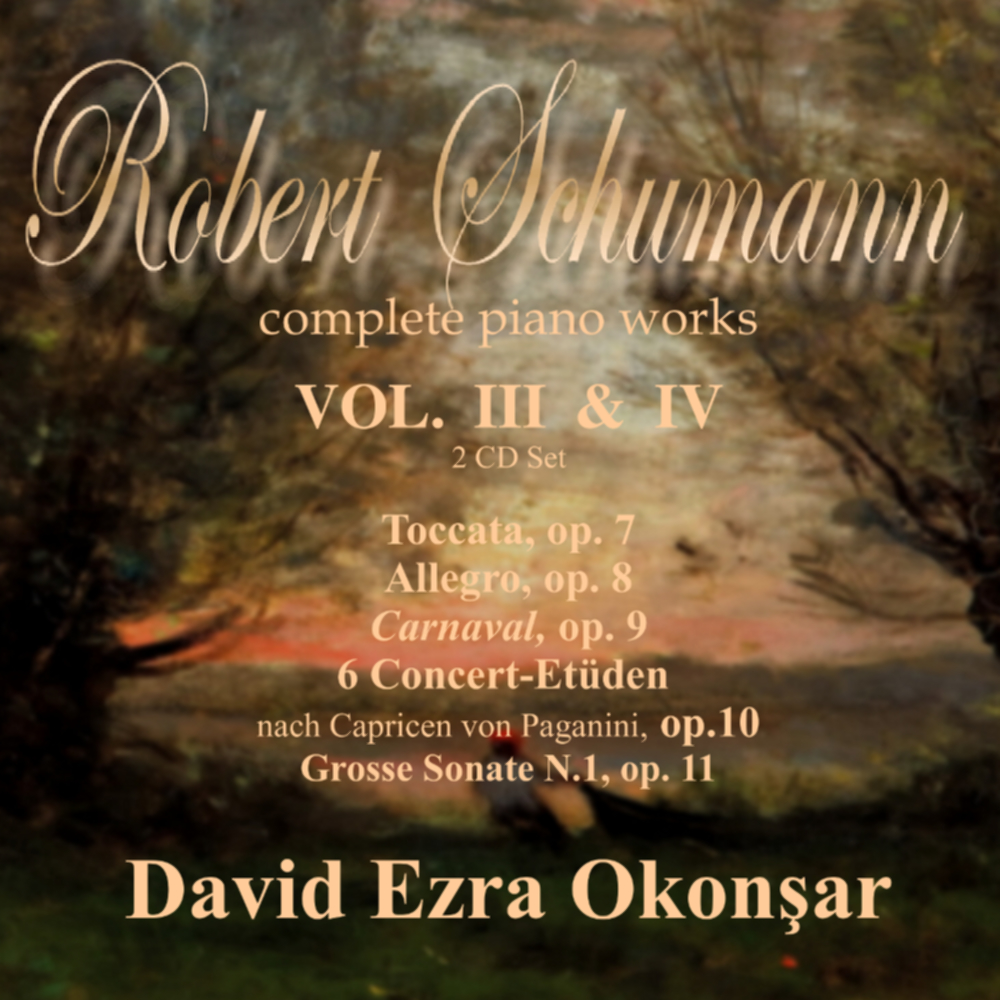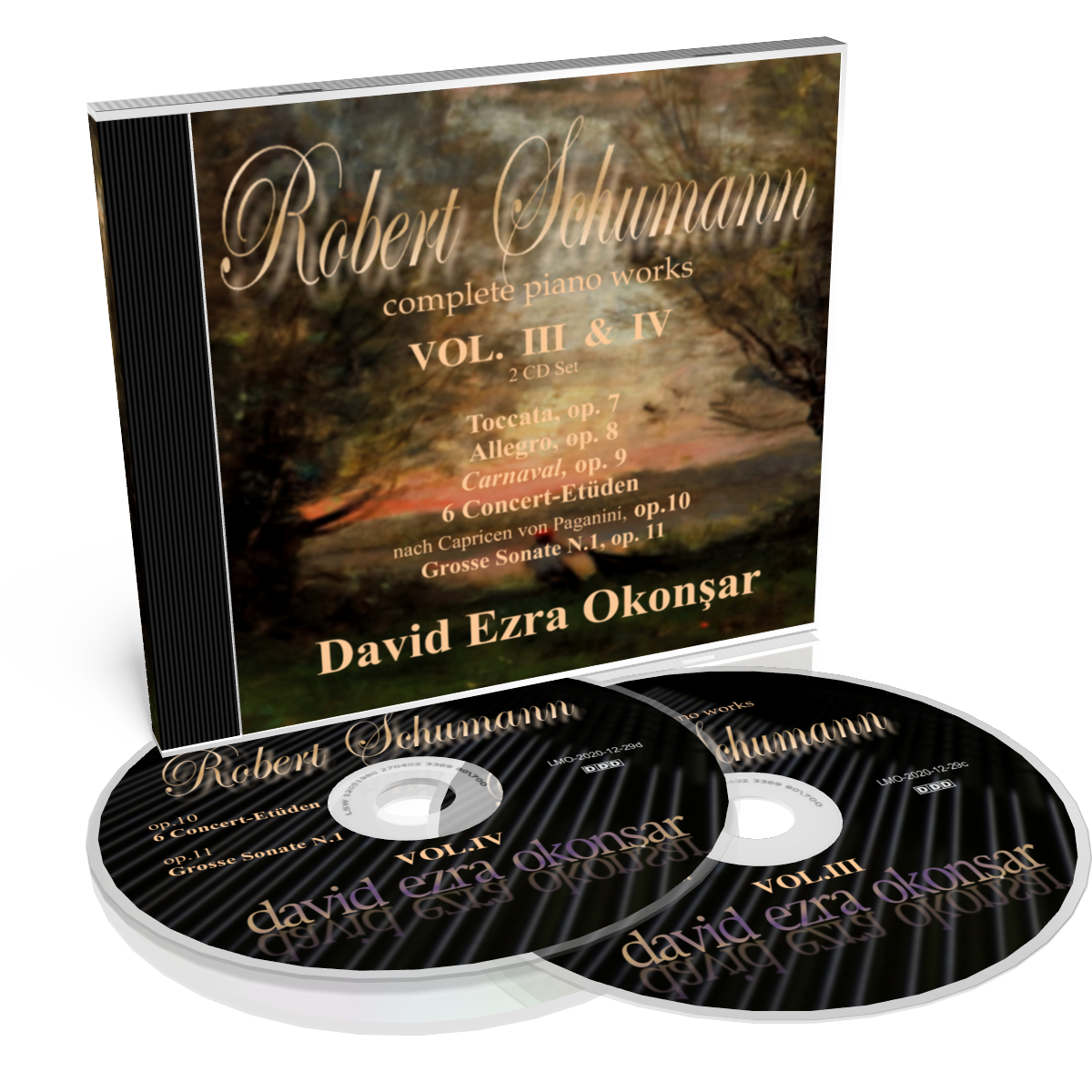

|
Robert Schumann
(1810-1856) Complete Works For The Piano
Early Years (b), Opus 7-11 (1835) From Toccata op.7 to Sonata N.1 in F-sharp minor op. 11 Two CD Set Toccata (1835) op.7 In the Toccata (1835), op.7, a outlandish piece, all the techniques refined in the Studies after Paganini will reach their apex. Deeply impressed by Paganini, Schumann was aspiring to write the most difficult piece of the entire piano repertoire! The work was first written in D major and titled “Etude fantastique”, then reworked in 1832 and named Toccata, following a titling tradition set by Carl Czerny for “moto perpetuum” style pieces Allegro in B Minor (1835) op.8 A major concern of the composer at this stage of his creative life was the grasping of the large-scale sonata form that he admired and extensively studied in the works of Beethoven. The Allegro in B Minor (1835), op.8 was his first attempt. The date of the composition of this beginning of a sonate is actually 1831. That is right after Abegg variations and Papillons. Even though many writers emphasized the “un-evenness” of the overall structure and the “feeble construction” of the large scale musical form, the sheer energy with which the 21 years old composer embark in such large a work (intended to be a full scale Sonata) with fresh and original musical ideas is worth performing and listening to. Carnaval (1835) op.9 While Clara was still a child, Robert was in love with Ernestine von Fricken, a young baroness from Boheme. They got secretly engaged in 1834, just before Ernestine left for her hometown Asch. Before the mutual feelings faded, this affair triggered th remarkable Carnaval (1835) op.9 around the Mardi-Gras day of 1835. First entitled “Scenes mignonnes sur quatre notes” this series is all based on four notes: ASCH which happen to be also the only “musical” letters of the name Schumann. After the eightieth piece of the series, Schumann presents, with the title “Sphinxes”, those very letters bare and un-harmonized, the key to the entire cycle. These letters are unveiled as three combinations of the name of the city where Ernestine lived: Asch. “EsCHA” (E-flat, C, B,A); “AsCH” (A-flat, C,B) and “AEsCH” (A, E-flat, C,B). Even though Carnaval is not the most impressive cycle of pieces Schumann ever composed, it is the most brilliant, the most colorful and varied one. Liszt admired this piece which he performed in concert in full.E Six Etudes after Paganini Caprices (1833-1835) op.10 Much more evolved than the first set, op.3 Études after Paganini Caprices (1832), this second series, Six Etudes after Paganini Caprices (1833-1835), op.10, aims to appear “like an original work for the solo piano” as stated by the composer. This elaboration often surfaces in various counter-melodies, ebullient accompaniment parts creating a very complex pianistic universe around themes by Paganini which are often quite naive and crudely harmonized in their original form. Even if those “studies” are not among the favorites brilliant concert pieces often performed by many virtuosi, they are nevertheless a milestone work paving the way for the Symphonic Studies op.13 (1834). Sonata N.1 in F-sharp minor (1835) op.11 The Sonata N.1 in F-sharp minor (1835), op.11, can be cited as the most significant of the three sonatas by Schumann. It is a huge scale work and the passionate exuberance of that year 1835, full of drama for the composer, is constantly fighting with his desire to potently command a wide-scale sonata form. A long enduring obsession for the young composer, see op.8. The dedication, for Clara of course, reads: “pour Clara, de Florestan et Eusébius”. The sonata was premiered by Clara Wieck in 1837, the very same year when the two lovers secretly got engaged. The immense piece was not fully appreciated by the audiences, yet Franz Liszt immediately noticed its uncommon quality and wrote a very favorable critique about it. A grandiose Allegro vivace starts with a monumental Introduzione. The very dense and tragic theme of this Introduction will be masterfully developed all through the first movement and also appear metamorphosed in the second (Aria). A delicately crafted Aria which makes for the second movement brings a peaceful interlude in this vast and tragic deploy. Somewhat strangely annotated: “senza passione ma espressivo” (without passion yet expressive), Liszt said for those forty-five bars which makes for the only slow movement of this sonata, “one of the most perfect things we know”. The Scherzo, also very compact as compared with the first and last movements, is quite Beethovenian almost a parody for the op.109 Sonata's scherzo. The interlude of this scherzo worth mentioning with its ironical annotation: Lento, alla burla ma pomposo, indeed the “Davidsbündler” and the “Filistines” are still present here. The last movement is almost a Sonata on its own and creates a wonderful balance with the first one. |
|||||||||||
|
|
|||||||||||
|





